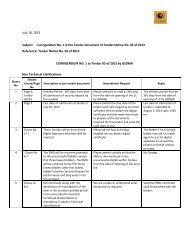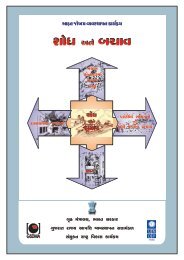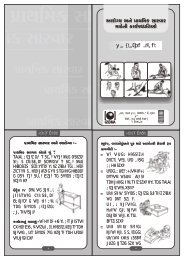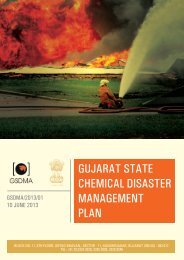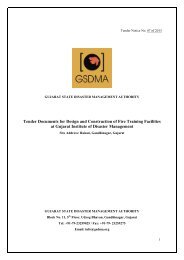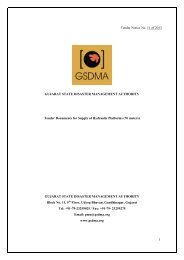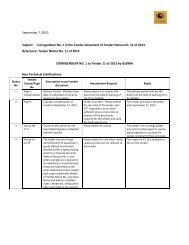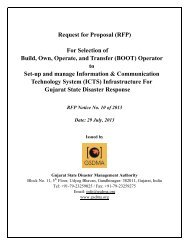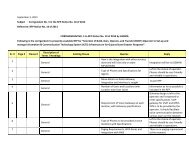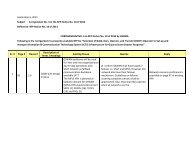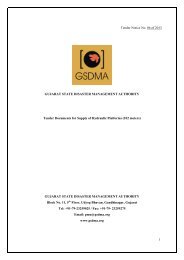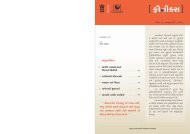Emergency Response Guidebook - Gujarat State Disaster ...
Emergency Response Guidebook - Gujarat State Disaster ...
Emergency Response Guidebook - Gujarat State Disaster ...
You also want an ePaper? Increase the reach of your titles
YUMPU automatically turns print PDFs into web optimized ePapers that Google loves.
In order to identify appropriate isolation and protective action distances, use the following: If youare dealing with a TIH/WRM/Chemical warfare material (highlighted entries in the index lists),the isolation and evacuation distances are found directly in the green-bordered pages. The guides(orange-bordered pages) also remind the user to refer to the green-bordered pages forevacuation specific information involving highlighted materials.If you are dealing with a non-TIH material but the guide refers to both TIH and non-TIHmaterials, an immediate isolation distance is provided under the heading PUBLIC SAFETY as aprecautionary measure to prevent injuries. It applies to the non-TIH materials only. In addition,for evacuation purposes, the guide informs the user under the title EVACUATIONSpill to increase,for non-highlighted materials, in the downwind direction, if necessary, the immediate isolationdistance listed under “PUBLIC SAFETY”. For example, GUIDE 131 – Flammable Liquids-Toxic,instructs the user to: "As an immediate precautionary measure, isolate spill or leak area for atleast 50 meters (150 feet) in all directions." In case of a large spill, the isolation area could beexpanded from 50 meters (150 feet) to a distance deemed as safe by the On-scene commanderand emergency responders.If you are dealing with a non-TIH material and the guide refers only to non-TIH materials, theimmediate isolation and evacuation distances are specified as actual distances in the guide(orange-bordered pages) and are not referenced in the green-bordered pages.Note 1: If an entry is highlighted in green in either the yellow-bordered or blue-bordered pagesAND THERE IS NO FIRE, go directly to Table 1 - Initial Isolation and Protective Action Distances(green-bordered pages) and look up the ID number and name of material to obtain initial isolationand protective action distances. IF THERE IS A FIRE, or IF A FIRE IS INVOLVED, ALSO CONSULT theassigned guide (orange-bordered pages) and apply as appropriate the evacuation informationshown under PUBLIC SAFETY.Note 2: If the name in Table 1 is shown with “When Spilled In Water”, these materials producelarge amounts of Toxic Inhalation Hazard (TIH) gases when spilled in water. Some Water Reactivematerials are also TIH materials themselves (e.g., Bromine trifluoride (1746), Thionyl chloride(1836), etc.). In these instances, two entries are provided in Table 1 for land-based and waterbasedspills. If the Water Reactive material is NOT a TIH and this material is NOT spilled in water,Table 1 and Table 2 do not apply and safety distances will be found within the appropriate orangeborderedguide.PROTECTIVE CLOTHINGStreet Clothing and Work Uniforms. These garments, such as uniforms worn by police andemergency medical services personnel, provide almost no protection from the harmful effects ofdangerous goods.Structural Fire Fighters’ Protective Clothing (SFPC). This category of clothing, often calledturnout or bunker gear, means the protective clothing normally worn by fire fighters duringstructural fire fighting operations. It includes a helmet, coat, pants, boots, gloves and a hood tocover parts of the head not protected by the helmet and facepiece. This clothing must be usedwith full-facepiece positive pressure self-contained breathing apparatus (SCBA). This protectiveclothing should, at a minimum, meet the OSHA Fire Brigades Standard (29 CFR 1910.156).Structural fire fighters’ protective clothing provides limited protection from heat and cold, butmay not provide adequate protection from the harmful Vapours or liquids that are encounteredduring dangerous goods incidents. Each guide includes a statement about the use of SFPC inincidents involving those materials referenced by that guide. Some guides state that SFPCprovides limited protection. In those cases, the responder wearing SFPC and SCBA may be able toperform an expedient, that is quick “in-and-out”, operation. However, this type of operation canplace the responder at risk of exposure, injury or death. The incident commander makes thedecision to perform this operation only if an overriding benefit can be gained (i.e., perform animmediate rescue, turn off a valve to control a leak, etc.). The coverall-type protective clothingcustomarily worn to fight fires in forests or wildlands is not SFPC and is not recommended norreferred to elsewhere in this guidebook.Positive Pressure Self-Contained Breathing Apparatus (SCBA). This apparatus provides aconstant, positive pressure flow of air within the facepiece, even if one inhales deeply while doingheavy work. Chemical-cartridge respirators or other filtering masks are not acceptablesubstitutes for positive pressure self-contained breathing apparatus. Demand-type SCBA doesnot meet the OSHA 29 CFR 1910.156 (f)(1)(i) of the Fire Brigades Standard. If it is suspected that aChemical Warfare Agent (CW) is involved, the use of NIOSH-certified respirators with CBRNprotection are highly recommended.Chemical Protective Clothing and Equipment. Safe use of this type of protective clothing andequipment requires specific skills developed through training and experience. It is generally notavailable to, or used by, first responders. This type of special clothing may protect against onechemical, yet be readily permeated by chemicals for which it was not designed. Therefore,protective clothing should not be used unless it is compatible with the released material. Thistype of special clothing offers little or no protection against heat and/ or cold. Examples of thistype of equipment have been described as (1) Vapour Protective Suits (NFPA 1991), also known asTotally-Encapsulating Chemical Protective (TECP) Suits or Level A* protection (OSHA 29 CFR1910.120, Appendix A & B), and (2) Liquid-SplashPage 362Page 363



